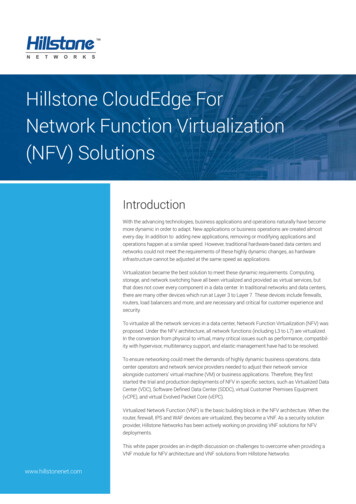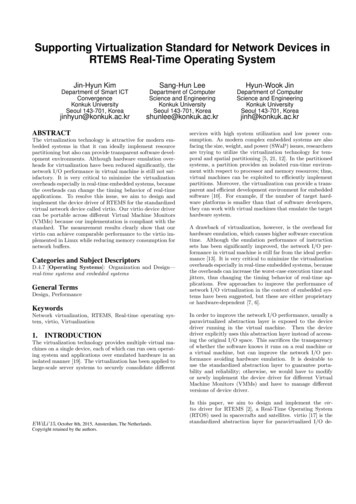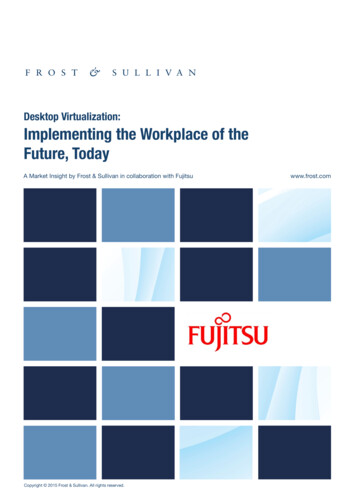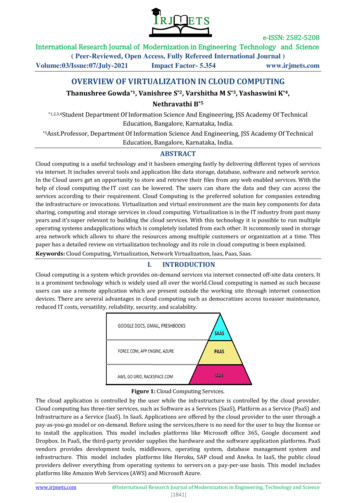
Transcription
Hillstone CloudEdge ForNetwork Function Virtualization(NFV) SolutionsIntroductionWith the advancing technologies, business applications and operations naturally have becomemore dynamic in order to adapt. New applications or business operations are created almostevery day. In addition to adding new applications, removing or modifying applications andoperations happen at a similar speed. However, traditional hardware-based data centers andnetworks could not meet the requirements of these highly dynamic changes, as hardwareinfrastructure cannot be adjusted at the same speed as applications.Virtualization became the best solution to meet these dynamic requirements. Computing,storage, and network switching have all been virtualized and provided as virtual services, butthat does not cover every component in a data center. In traditional networks and data centers,there are many other devices which run at Layer 3 to Layer 7. These devices include firewalls,routers, load balancers and more, and are necessary and critical for customer experience andsecurity.To virtualize all the network services in a data center, Network Function Virtualization (NFV) wasproposed. Under the NFV architecture, all network functions (including L3 to L7) are virtualized.In the conversion from physical to virtual, many critical issues such as performance, compatibility with hypervisor, multitenancy support, and elastic management have had to be resolved.To ensure networking could meet the demands of highly dynamic business operations, datacenter operators and network service providers needed to adjust their network servicealongside customers’ virtual machine (VM) or business applications. Therefore, they firststarted the trial and production deployments of NFV in specific sectors, such as Virtualized DataCenter (VDC), Software Defined Data Center (SDDC), virtual Customer Premises Equipment(vCPE), and virtual Evolved Packet Core (vEPC).Virtualized Network Function (VNF) is the basic building block in the NFV architecture. When therouter, firewall, IPS and WAF devices are virtualized, they become a VNF. As a security solutionprovider, Hillstone Networks has been actively working on providing VNF solutions for NFVdeployments.This white paper provides an in-depth discussion on challenges to overcome when providing aVNF module for NFV architecture and VNF solutions from Hillstone Networks.www.hillstonenet.com
Challenges in VNF ImplementationsThe major functional differences between traditional networkfunctions and virtualized network functions reside in the followingareas: Self-service Self-configuration ElasticityIn addition, virtualized functions must provide a northbound API tobe integrated by higher level management software.Key features required by NFV architecture on VNF are discussed inthe following sections.Automatic Deployment and CompatibilityAutomatic deployment and configuration are necessary to enableand support self-service and self-management. Without theintervention of data center administrators, customers or tenantsshould be able to achieve self-service and self-management, similarto the services provided by public clouds such as AWS, Azure, orother cloud providers.Deployment using image or templateVNF has to provide VM image or deployment templates to achieverapid deployment when customers need to start a new servicequickly to address a business demand.Support for multiple cloud platformsHybrid-cloud and heterogeneous-cloud services will stay inbusiness for a long time. On the management side, cloud management platforms are capable of managing multiple cloud platforms.For example, one management platform can manage a VMwaredata center, an OpenStack data center, and AWS as well. To providea single solution to a cloud operator, VNF has to support multiplecloud platforms, which usually include VMware, OpenStack, AWS,Azure, Ali Cloud, among others.Embedded automatic configurationAfter being deployed through one single VM image or template,multiple VNF instances will contain the same configurations, suchas interface IP, route, username, or password. This makes themunusable by multiple customers or tenants. It is necessary toautomatically customize certain configurations after a VNF isdeployed.There are multiple approaches to implement an automaticconfiguration, like updating the configuration file before VNF bootsup, embedding a startup agent (VMware and Azure), or reading auser specific configuration (AWS and OpenStack) during boots up.Scalability and ElasticitySince business applications and operations may change over timethrough expansion or reduction, services provided by VNF mustscale up or down as necessary.To provide the above scalability, VNF needs to provide overallperformance scaling by adjusting virtual resources (virtual CPU andmemory) on a single VNF VM, and avoid redeploying it. Similarperformance scalability requirements are also applied on VNFnetwork interfaces. The VNF interface has to support Single RootI/O Virtualization (SR-IOV) and hot plug-and-play.If certain features or the performance of VNF are controlled by alicense, license management has to be scalable as well; otherwise itwill block performance scaling.Open API and Software OrchestrationVNF module is managed by other orchestration software. Theorchestration software can be NFV Management and Orchestration(MANO) software or VNF Manager (VNFM).Orchestration softwareincludes OPEN-O, OSM, Tacker, etc. Since SDN does not follow thestandard defined by European Telecommunications StandardsInstitute (ETSI), it is not classified as NFV orchestration software.The management software is capable of orchestrating multipletypes of, and multiple instances of NFV modules through acentralized console. It not only supports the daily operations of acloud administrator, but also implements service chains andensures continuous deployment and upgrades.Since the orchestration software needs to configure VNF andmanage its execution, VNF needs to provide the northboundinterface for upper management software, like SOAP, XML or RESTAPI.
VNF Solution from Hillstone NetworksThe goal of NFV is to improve the efficiency of deploying newservices and adjusting existing services to meet the demands ofhighly dynamic business operations. Compatibility, elasticity, highperformance, and open API are all crucial to an NFV solution.Besides the above features, automatic orchestration and licensemanagement are also key functions in the service orchestrationprocess. Orchestration ensures each VNF module can be deployedand configured automatically, including initial and customizedconfiguration based on each specific service. License managementensures VNF modules can automatically enter operation mode.How Hillstone NFV solutions address these requirements isdiscussed in the following sections.Hillstone VNF is Highly CompatibleHillstone provides a highly compatible virtual firewall, which cansupport four major hypervisors: ESXi, KVM, Hyper-V, and Xen server.Hillstone’s VNF solution also supports multiple cloud platforms,including VMware, OpenStack, AWS, Azure, and Ali Cloud. It hasbeen integrated into the cloud solutions from multiple cloudproviders, like 99cloud (OpenStack Gold Member), EasyStack(OpenStack Gold Member), ZTE, Inspur, and HUAWEI.Figure 1 shows the partners and compatible cloud providers ofHillstone VNF.Figure 1. Partners and compatible cloud providersAutomatic Deployment and Initial ConfigurationFor different cloud platforms, Hillstone provides multiple formats ofVNF images (ova, vhd, qcow2) to meet various customer requirements. Virtual resources for the virtual firewall have been pre-configured to ensure a fast and successful deployment.An embedded agent is used to retrieve the initial configurationduring the boot-up process to customize each VNF module basedon customer requirements. Hillstone has integrated vmtools,cloud-init, Qemu Guest Agent into the VNF module. With embeddedagents, the interface IP, route, username, and password can beinjected into the VNF during the module boot up process.Automatic License ManagementAfter the automatic deployment and initial configuration iscomplete, the VNF module is not yet fully functional because itsfeatures are also controlled via a license. To ensure VNF modulescan closely follow user requirements to start, adjust, or shut down,license management also needs to implement automatic dispatchand recycle mechanisms.Hillstone released the License Management Server (LSM) to providea license management solution for VNF deployments. When aHillstone VNF module requires a license during start up, it willconnect to the LSM. The LSM can assign certain licenses to themodule based on pre-configured rules. When VNF’s configurationneeds to be adjusted to meet user requirements, it can get updatedlicenses from LSM. When a VNF completes its service and is beingterminated, LSM can recycle its licenses and the licenses cansubsequently be re-assigned to other VNF modules.
With the help of LSM, licenses are automatically assigned orrecycled whenever the VNF module starts, adjusts, or terminates.This ensures network services scale along with customer requirements.Elasticity and High PerformanceBesides scaling out by automatically deploying more VNF modules,a single VNF module is also capable of scaling up to meet therequirement based on network topology changes and performance.When new virtual networks are created based on a business needthrough the interface plug-and-play feature, a single VNF modulecan provide more network interfaces at run-time to connect tonewly created VM virtual networks.REST APICustomers typically need to manage multiple types of networkservices from cloud platforms to fulfill business requirements. Toimprove the user experience and reduce operational complexity,cloud service providers usually provide a single management portaland integrate management and configuration on multiple virtualservices and resources on that portal. To be managed andconfigured by the management portal, the VNF module has toprovide northbound interface to upper level management software.Thus a cloud user can manage all services from a single portal.Hillstone VNF also provides the capability to automatically adjustvirtual resources. Without re-deploying the VNF module, moreresources can be utilized after new resources (vCPU and memory)are assigned and a new license with higher capacity is loaded.REST API is a popular interface standard, and major cloud management platforms (AWS, Azure, and OpenStack) support it. Tointegrate with a cloud management platform or other types ofmanagement software, Hillstone VNF provides REST API formodule management and service configuration. Through REST API,cloud service providers can push configurations to VNF modulesand provide a self-management service to cloud users through itsmanagement portal.Increasing virtual resources (like vCPU and memory) can help toincrease the VNF performance to a certain extent. When thisapproach reaches its limit, VNF can enable the support of SR-IOVand further improve the interface throughput close to line rate.Currently, Hillstone VNF REST API supports system configuration,security policy configuration, interfaces and network configurations.Figure 2 shows a portion of the Hillstone VNF REST API specification.Figure 2. Hillstone VNF REST API specification
NFV OrchestrationIn the standard NFV framework from ETSI, NFVO uses VNFM toorchestrate VNF services. VNFM uses info from VNFD to requestresources from VIM, deploy VNF, and manage virtual networks.Figure 3 shows the standard ETSI NFV framework.Figure 3. ETSI NFV frameworkHowever, in real world customer environments, because of thedifferences in underlying technologies and levels of operation, cloudinfrastructures may not strictly follow the above NFV framework. Tobest fit into customers’ environments and reduce challenges indeployment and integration, Hillstone provides three types of NFVorchestration solutions, outlined below. Orchestration based on cloud platformIn this approach, Hillstone VNF integrates with a cloud platform orcloud management platform. With minor integration efforts, cloudoperators can manage and configure Hillstone VNF from existingmanagement frameworks.Hillstone provides multiple types of VM images to support differenttypes of hypervisors, LSM to support automatic license management, and an embedded agent to support automatic customizedconfigurations. Hillstone also provides a management agent, whichcan integrate with a cloud management platform and provide anAPI interface for advanced integration.Hillstone VNF has been orchestrated by vCenter and OpenStackwith this approach, and also integrated with 3rd party cloudplatforms through a similar approach. For example, Hillstone VNFhas been integrated into HUAWEI cloud orchestration, and allowsHUAWEI cloud to manage VNF life cycle and configuration.Figure 4 shows the block diagram of orchestration based on cloudplatform.
Figure 4. Orchestration based on cloud platform Orchestration based on OpenStack FWaaS PluginHillstone VNF module can be integrated with OpenStack Firewall asa Service (FWaaS) plugin and can be managed by FWaaS plugin. Inthis solution, Hillstone Networks provides a new component, virtualService Orchestration Module (vSOM). Under an OpenStackdeployment, in the process of creating a vrouter or firewall, a vSOM,HillstoneNetworks-L3-agent or HillstoneNetworks-FWaaS-driver caninitiate a Hillstone VNF module to act as the vrouter or firewall, toreplace the native vrouter or iptables based firewall.With this approach, the workflows of vrouter and FWaaS creationremain the same, and can be managed from the native OpenStackmanagement portal, Horizon. Hillstone VNF achieves seamlessintegration with OpenStack through minimum change on theOpenStack management platform. Figure 5 shows the frameworkfor this integration approach.Figure 5. Orchestration based on OpenStack FWaaS
Orchestration based on open source MANOMultiple open source MANO solutions (OPEN-O, OSM, Tacker, etc.)are available in the market. By using an open source MANO solution,cloud service providers can implement more flexible orchestrationsolutions. They also can do further development to meet the needsof their business or customers.Topology and Orchestration Specification for Cloud Applications(TOSCA), is an OASIS standard language used to describe atopology of cloud based web services, their components, relationships, and the processes that manage them. Many NFV/VNFvendors follow and use TOSCA to describe and specify a VirtualNetwork Function Descriptor (VNFD). Specified with TOCSA andworking with open source MANO, VNFD orchestrates servicemodules from disparate vendors. This approach ensures NFVservices from different vendors are fully decoupled.Hillstone provides a TOSCA based VNFD template for its VNFmodule. Through the orchestration of open source MANO, HillstoneVNF can be deployed as a standalone module, a pair with highavailability, or one module in Service Function Chaining (SFC). Thisapproach follows ETSI standard and is the ideal solution for NFVorchestration.Figure 6 shows portions of Hillstone VNFD and VNFFGD.Figure 6. Hillstone VNF VNFD and VNFFGD template samplesFigure 7 shows the block diagram of orchestration based on open source MANO.Figure 7. Orchestration based on open source MANO
Customer Success StoriesHillstone CloudEdge is a virtual firewall VNF solution for NFVdeployment. Hillstone Networks has a long-standing and extensivepartnership with cloud service providers in developing and enhancing this solution. Real customer deployments and Proof of Concept(PoC) cases of Hillstone CloudEdge are described in the followingsections:Use case 1: Protecting North-South Traffic onCloud PlatformA major cloud service provider integrates Hillstone CloudEdge withembedded vmtools into its cloud platform. Through CloudEdgeREST API, the cloud management platform integrates the CloudEdge security policy configuration into its existing managementuser interface and provides unified management to its customer.From its management portal, customers can configure and applyNAT rules, security policies, and access control rules to HillstoneCloudEdge .Use case 2: Orchestration through HEATOne OpenStack integrator (OpenStack Gold Member) integratesHilltone CloudEdge with embedded cloud-init into its OpenStacksolution. CloudEdge image is initiated through a HEAT template andcustomized configurations are sent to CloudEdge through RESTAPI.Use case 3: Replace vrouter in OpenStackDeploymentIn a vertical cloud designed for one province in China, the cloudservice provider integrates Hillstone CloudEdge through anOpenStack FWaaS plugin. Hillstone Networks-L3-agent convertsfirewall policies received from the cloud management platform tothe Hillstone policy format, and pushes the policies into theCloudEdge module. When a user/tenant creates a new Layer 3network on the cloud management platform, the Hillstone CloudEdge is automatically created or configured to act as a vrouter forthe network.Use case 4: Replacing OpenStack Native FirewallA level one Telco in China is designing an internal data center basedon an NFV architecture. OpenStack is chosen to be used as the VIM.Their home-grown orchestration software manages both SDN andHillstone CloudEdge modules. Hillstone CloudEdge is used toreplace the OpenStack native firewall. HillstoneNetworks-FWaaS-driver is used to achieve automatic deployment,convert FWaaS policy to the Hillstone policy format, and buildservice chains along with SDN controller.ConclusionNFV is a favorite choice in the path of transforming traditionalnetworks to virtualized networks. Now both traditional networkdevice vendors and traditional network service providers arestarting to upgrade or converge to NFV. The complete NFV solutionrequires deploying multiple different types of, as well as many VNFmodules. This type of deployment is typically complex and requirescomplete automatic orchestration support.Hillstone Networks has been actively working in the area of cloudcomputing. Hillstone CloudEdge provides multiple integrationsolutions for various cloud platforms and has been deployed intomultiple test and production cloud environments to serve multipleindustries and customer requirements. Hillstone will continue toinvest in cloud computing and develop solutions for hybrid-cloudand heterogeneous clouds, to continue to deliver ever more flexible,user-friendly, and robust solutions to the market.How to contact Hillstone NetworksAmericas: 1-408-508-6750 SEA: 65-6678-7660Europe: 420-721-125-070 MEA: 971-4557-1493Email: inquiry@Hillstonenet.com
To virtualize all the network services in a data center, Network Function Virtualization (NFV) was proposed. Under the NFV architecture, all network functions (including L3 to L7) are virtualized. In the conversion from physical to virtual, many critical issues such as performance, compatibil-ity with hypervisor, multitenancy support, and elastic management have had to be resolved. To ensure .










